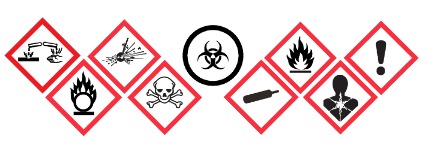Canada has adopted GHS (WHMIS 2015)

Canada has adopted GHS (WHMIS 2015). What does this mean? On February 11, 2015, the Government of Canada officially passed the GHS (Globally Harmonized System) to better follow the internationally recognized standard for hazard classification and communication into WHMIS. Health Canada’s program, WHMIS 2015, will be a transitional process to conclude December 1, 2018.
What is GHS??
GHS stands for Globally Harmonized System. It is an internationally agreed-upon system, created by the United Nations. It is designed to replace the various classification and labeling standards used in different countries by using a consistent method for classification, safety data sheet information, symbols and labeling on an international level. This will harmonize the movement of hazardous products globally.
What is WHMIS 2015??
On February 11, 2015, the Government of Canada published the Hazardous Products Regulation (HPR) in the Canada Gazette, Part 2. The Workplace Hazardous Materials Information System (WHMIS), Canada’s national hazard communication standard, is being modified to incorporate the Globally Harmonized System of Classification and Labelling of Chemicals (GHS) – an internationally recognized standard for hazard classification and communication.
The new requirements within the Hazardous Products Regulation (HPR) and the Hazardous Products Act (HPA) will bring forth changes to the existing WHMIS (WHMIS 1988). The Globally Harmonized System of Classification and Labelling of Chemicals (WHMIS 2015) will align Canada’s system with the United States Hazard Communication Standard (2012) (Hazcom 2012) and the United Nations Regulations/Recommendations (Purple Book, Revision 5).
The Requirements for worker safety will remain the same Federally through Health Canada or through each Provincial and Territorial authority, in that all employees must be trained and competent to comply with the new regulations in WHMIS 2015.
How does WHMIS 2015 impact Canada?
Here in North America, Prime Minister of Canada, Steven Harper, and the President of the United States Barack Obama, announced the Joint Action Plan for Canada-US Regulatory Cooperation Council on December 7, 2011 and made a commitment to align and synchronize implementation of common classification and labelling requirements for workplace hazardous chemicals. This announcement has committed Canada to the implementation of the Globally Harmonized System (GHS) of Classification and Labelling of Chemicals for workplace chemicals in Canada.
What this means is that the current WHMIS (1988) Regulations will be changing to meet the GHS Regulations established by the United Nations. As well as the requirements and recommendations of the United Nations, Canada has chosen to omit some classification requirements and pictograms/symbols from the Canadian WHMIS legislation. Environmental Hazards and Aquatic Toxicity do not fall within the jurisdiction of Health Canada and therefore have been omitted from WHMIS 2015. These however are regulated by other Federal and Provincial/Territorial legislation.
How will WHMIS 2015 affect Canadian businesses??
All businesses in Canada must comply with all of the changes from WHMIS 1988 to WHMIS 2015 (GHS). The name of the Regulation will still remain as WHMIS, as this is a recognized “household” term throughout workplaces in Canada. The designation of “2015” is to decipher between the new regulations and the previous ones.
What this means for your business are changes or additions of classification, changes relating to pictograms, changes to labelling and symbols, and changes to Safety Data Sheets (SDS). There are enough changes from the current WHMIS legislation to the new WHMIS 2015 that companies should understand how this applies to their workplace and the hazards that employees work with or in proximity to.
When does it happen??
In June 2014, the amended Hazardous Products Act (HPA) received Royal Assent. These changes will enable Canada’s implementation of the new WHMIS 2015 (GHS) for workplace chemicals. The Hazardous Products Regulations (HPR), which will replace the Controlled Products Regulations, were published in the Canada Gazette Part I in August 2014, followed by a consultation period. Final regulations were published in Canada Gazette Part II February 11, 2015 for full implementation December 1, 2018.
| Phases | Timing | Suppliers | Employers | |
| Manufacturers and Importers | Distributors | |||
| Phase 1 | From coming-into-force to May 31, 2017 | Comply with CPR or HPR requirements | Comply with CPR or HPR requirements | Consult FPT OSH regulator |
| Phase 2 | From June 1, 2017 to May 31, 2018 | Comply with HPR requirements | Comply with CPR or HPR requirements | Comply with CPR or HPR requirements |
| Phase 3 | From June 1, 2018 to November 30, 2018 | Comply with HPR requirements | Comply with HPR requirements | Comply with CPR or HPR requirements |
| Completion | December 1, 2018 | Comply with HPR requirements | Comply with HPR requirements | Comply with HPR requirements |
How can Global HazMat help??
Our 2015 WHMIS Training and Consulting services offers Onsite customized classroom training, Train the Trainer courses, Online/E-learning training, Self- Study training manuals, Customized Audits and onsite evaluations of your current programs and procedures.
We carry GHS pocketbooks, posters, Trainers/Instructors packages, GHS customized and stocked labels, and SDS (safety data sheet) management services. If you have a question or want to pre-order training materials to take advantage of early discounts contact our sales team @ 1-877-744-4999 or sales@globalhazmat.com
